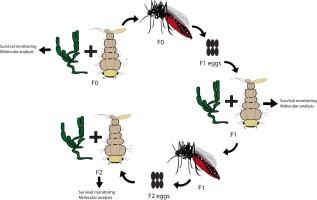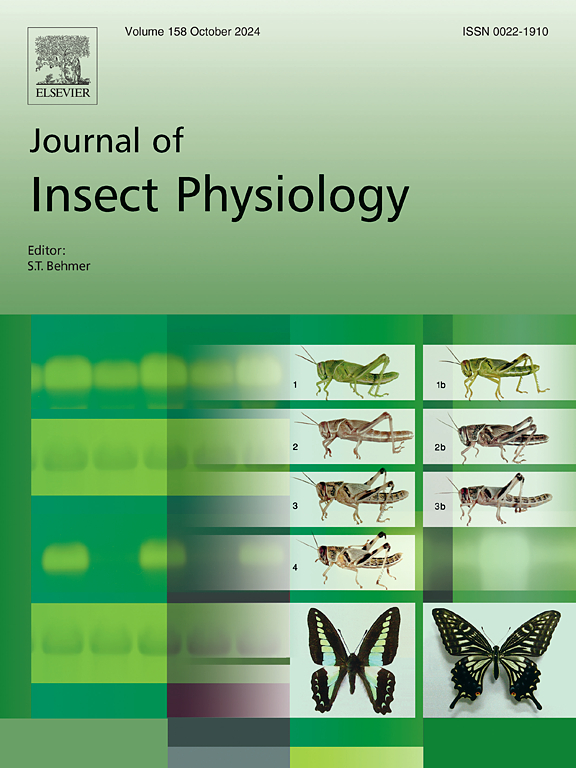埃及伊蚊暴露于 Metarhizium anisopliae 后抗菌肽的多代表达:是否涉及跨代免疫引物?
IF 2.3
2区 农林科学
Q1 ENTOMOLOGY
引用次数: 0
摘要
我们首次评估了埃及伊蚊幼虫暴露于昆虫病原真菌Metarhizium anisopliae时抗菌肽(AMPs)的多代表达,并将其与可能的跨代免疫启动(TGIP)联系起来。首先将埃及伊蚊幼虫暴露于M. anisopliae CG 489的囊孢或分生孢子中24小时和48小时,然后使用Real-Time PCR定量检测AMPs的相对表达。制备了分生孢子悬浮液,并用不同的幼虫世代(F0、F1 和 F2)进行了两种不同的存活试验。在第一种生物测定中,分别测定了三代幼虫的存活曲线,并与各自的对照组进行了比较。在另一项生物测定中,同时将 F0、F1 和 F2 代的存活曲线与暴露于吐温 80 的原始组进行比较。在这两项存活率测试中,F0 代对 M. anisopliae 的易感性均高于其后各代。为了进行与 TGIP 相关的分子分析,将 F0、F1 和 F2 幼虫暴露于分生孢子,并将其 AMPs 的表达与其对照组和天真组进行比较。各代幼虫的头孢霉素、防御素 A 或酪蛋白酶 B 的表达没有差异。然而,溶菌酶 C 在各代之间的表达量有所增加,这表明溶菌酶 C 在 TGIP 中发挥作用。这些发现可能有助于我们开发基于昆虫病原真菌的针对蚊子幼虫的生物杀虫剂。本文章由计算机程序翻译,如有差异,请以英文原文为准。

Multigenerational expression of antimicrobial peptides in Aedes aegypti exposed to Metarhizium anisopliae: Is trans-generational immune priming involved?
We assessed, for the first time, a multigenerational expression of antimicrobial peptides (AMPs) in Aedes aegypti larvae exposed to the entomopathogenic fungus, Metarhizium anisopliae, and correlated it with a possible involvement in trans-generational immune priming (TGIP). Aedes aegypti larvae were first exposed to blastospores or conidia of M. anisopliae CG 489 for 24 and 48 h, and the relative expression of AMPs were measured using quantitative Real-Time PCR. A suspension of conidia was prepared, and two different survival tests were conducted with different larval generations (F0, F1, and F2). In the first bioassay, the survival curves of the three generations were conducted separately and compared with their respective control groups. In the other bioassay, the survival curves of the F0, F1, and F2 generations were compared simultaneously against a naïve group exposed to Tween 80. In both survival tests, the F0 generation was more susceptible to M. anisopliae than subsequent generations. For molecular analyses related to TGIP, F0, F1, and F2 larvae were exposed to conidia, and their expression of AMPs was compared with their control groups and a naïve group. There was no differential expression of cecropin, defensin A or cathepsin B between generations. Lysozyme C, however, showed an increase in expression across generations, suggesting a role in TGIP. These discoveries may help us develop biological insecticides against mosquito larvae based on entomopathogenic fungi.
求助全文
通过发布文献求助,成功后即可免费获取论文全文。
去求助
来源期刊

Journal of insect physiology
生物-昆虫学
CiteScore
4.50
自引率
4.50%
发文量
77
审稿时长
57 days
期刊介绍:
All aspects of insect physiology are published in this journal which will also accept papers on the physiology of other arthropods, if the referees consider the work to be of general interest. The coverage includes endocrinology (in relation to moulting, reproduction and metabolism), pheromones, neurobiology (cellular, integrative and developmental), physiological pharmacology, nutrition (food selection, digestion and absorption), homeostasis, excretion, reproduction and behaviour. Papers covering functional genomics and molecular approaches to physiological problems will also be included. Communications on structure and applied entomology can be published if the subject matter has an explicit bearing on the physiology of arthropods. Review articles and novel method papers are also welcomed.
 求助内容:
求助内容: 应助结果提醒方式:
应助结果提醒方式:


